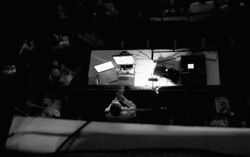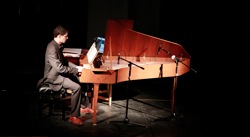Dublin Sound Lab at InnerSound New Arts Festival, Bucharest
Composer and Dublin Sound Lab co-director, Fergal Dowling reports on his experience at the InnerSound New Arts Festival, Bucharest 
This August, with the assistance of Culture Ireland, Dublin Sound Lab travelled to Bucharest to take part in the first InnerSound New Arts Festival. We presented a programme of mixed works for harpsichord solo, multi-channel ‘tape’, harpsichord with ‘tape’, and one computer-mediated interactive work.
We had been invited by Cătălin Creţu (composer and president of the Opus Association, one of the main festival organisers) to prepare a programme for the festival. The festival adopted a deliberately international outlook which was reflected in the selection of performers from the Netherland, Germany, Greece, Ireland, Romania and Switzerland. We devised a programme of representative works displaying a range of techniques and which also represented Irish composition. The final programme framed Gerald Barry’s, Sur les Pointes (harpsichord solo), my own Sketch (harpsichord and computer) and Jonathan Nangle’s, dying from the moment it’s struck (eight-channel ‘tape’) between Kaija Saariaho’s Jardin Secret II (harpsichord and four-channel ‘tape’) and Jean-Claude Risset’s Pentacle (harpsichord and eight-channel ‘tape’).
The InnerSound Festival continued over three days and was spread across a number of sites. Our concert on the opening day of the festival, 28 August, took place at the Opera Studio. This ‘new arts’ festival included a number of multimedia performances, interactive installations, and other devised and improvised dance/audio/visual works. One typically imaginative and cross-disciplinary collaborative event was a Silent Film Night in which eight video artists and filmmakers were united with eight young Romanian composers, and each pair created an audiovisual project for an outdoor performance with live music, purposefully for the InnerSound Festival.

In this context Dublin Sound Lab’s ‘multimedia’ programme featuring ‘tape’ works, interactive and solo harpsichord works was one of the few audio-only programmes over the three days of the festival. For this performance I made a special reworking of Sketch in which the parts for actor and viola (originally performed and recorded by Bryan Quinn and Garth Knox in Paris, 2011) were rendered as fixed-media parts. This resulted in the curious situation in which Michael’s live harpsichord part triggered samples, and then interacted with, and re-recorded these replayed samples ‘live’ while continuing to re-trigger multiple simultaneous selections from the growing sample reservoir. The piece is inspired by Worstword Ho and mimics some of Beckett’s structural principles, so this self-referential act seemed to suit the underlying humour of the composition.
Our programme required multichannel surround sound system to encircle the audience for all but one of the items. On our first day we spent four hours setting up and configuring the loudspeakers, then testing and adjusting the electronic parts to suit the array during the second day. So it was only after our concert that we really had a chance to meet the other festival organisers, the composers Diana Rotaru and Sabina Ulubeanu, and the other performers. We did manage to have a meeting with David Costello, First Secretary of the Irish embassy in Bucharest and an interview with Radio România Muzical. We also enjoyed meeting Romanian composers and performers, such as Alexandru Solonaru. Alexandru is co-founder of the Propuls Ensemble which had recently performed Kevin Volans’s White Man Sleeps at 2.00am in the middle of a forest (!) as part of the Forest Vibes Fest held in a valley in the Subcarpathian hills to the north of Bucharest.
We could only stay a very short while in Bucharest, and for most of that we were completely absorbed in preparations for our programme. Nevertheless, we were very aware that we were participating a very well organised event that had caught the public imagination with its very deliberate programming of multimedia and cross-disciplinary performances aimed explicitly to dissolve perceived boundaries between various art forms and separate artform audiences. The enthusiasm of both organisers and audience has impressed us and we hope that we will have the opportunity to contribute another Dublin Sound Lab programme to next year’s festival.
See also: an interview with the Fergal Dowling and Michael Quinn about the concert.
